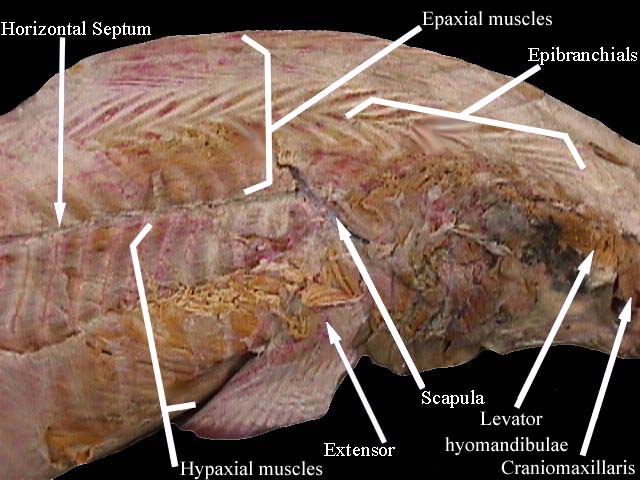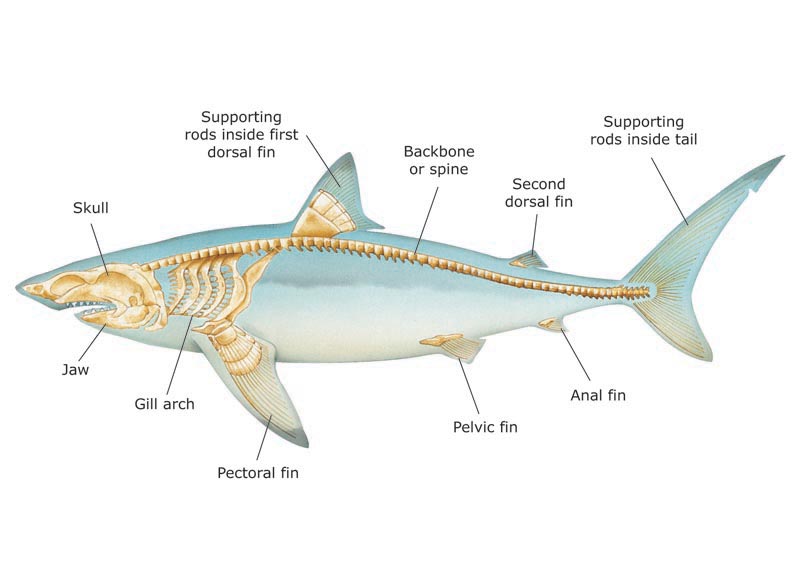
Shark Lab
Activity 7: Muscular & Skeletal Systyems
Click HERE to access the Activity 7 Dissection Booklet
| All the foregoing
skeletal elements would compose a complex and grotesque statue were it not
for muscles to animate them. Muscles transform the cartilaginous
architecture of a shark into fluid, graceful art. Perhaps in part because
it is so difficult to move through water efficiently, sharks are very
muscular animals. Something on the order of 85% of a 'typical' shark's
body weight is muscle, compared with about 35 to 45% for humans.
Just as in humans (and holiday turkeys), sharks have two basic types of muscle, red and white. Red muscle is relatively slow-contracting and requires an oxygen-rich operating environment, but has tremendous stamina. White muscle is relatively fast-contracting, does not require an oxygen-rich environment, but tends to become exhausted rather quickly due to the build-up of lactic acid (a somewhat toxic cellular waste product). While white muscle comprises only a tiny percentage of human muscle, over 90% of a shark's muscle mass is composed of white muscle. As described earlier (in the section on body form and swimming style), the Great White and other lamnid sharks have - to various extents - augmented their swimming muscles with bands of red muscle along their flanks. This adaptation probably grants the White Shark greater swimming endurance than a shark whose swimming muscles are entirely composed of white muscle. Shark swimming muscles, like those of most fishes, are composed of W-shaped blocks called "myotomes". These myotomes interdigitate in complex ways, with some parts of an individual muscle block extending forward and others back to form a series of intermeshing cones. This generates a body wave that propegates smoothly and sinuously along the body and - with the addition of a caudal fin - produces the vast majority of a shark's propulsive force. In cross section, shark swimming muscles form bundles of concentric rings that meet at the midline of the body underneath the lateral line (a vibration-detecting sensory system that extends along the flanks of fishes). Those muscle bundles above the lateral line are termed "epaxial" (back), those below "hypaxial" (flank). The arrangement of muscle fibers in a shark is quite different from fish that belong to class Osteichthyes. In a bony fish, the muscle fibers tend to loop back on themselves, whereas in sharks, the muscle fibers attach to tough longitudinal struts composed of connective tissue. These struts may act as an auxiliary muscle attachment point along the flanks, compensating for sharks' lack of ribs. Other muscles control sharks' fins, raising, lowering and flexing these foils to control every aspect of swimming. In conditions under which it is difficult to breathe, some sharks flare or rhythmically pump their gill slits to move oxygen-bearing water over their gill membranes. The White Shark may flare its gill muscles to facilitate oxygen-uptake when its mouth is temporarily 'plugged' with food prior to swallowing. Yet other muscles control the throat. Many sharks - such as the Nurse (Ginglymostoma cirratum), wobbegongs (family Orectolobidae), and angel sharks (Squatinidae) - can create powerful pharyngeal suction by rapidly expanding their muscular throats. The Great White can also create such a pharyngeal suction, though rather more weakly than in some sharks. Although young White Sharks may rely on this strategy to hoover up small fishes, when older and larger, this species tends to employ a more dramatic approach to grasping and dismembering large prey.
|

|
| Shark Skeletal System
Sharks are vertebrates – they have a skeleton with a backbone, but it has no bones! Its skeleton is made out of a substance called cartilage, or gristle. This is very strong and light, and also slightly bendy. A shark’s bendy skeleton gives it flexibility, helping it to twist and turn in the water. As well as being very flexible, cartilage is lighter than bone, giving sharks lots of strength without making them heavy.
Sharks have thick layers of muscles just under their skin. They are used to move the body from side to side. Sharks have many close relations who, like themselves, have a skeleton made of cartilage rather than bone. Other kinds of cartilaginous fish include skates and rays. Most other fish have bones instead of cartilage. They are called ‘bony fish’, while sharks, rays and skates are known as ‘cartilaginous fish’. Although human skeletons are made of bone, they have a small amount of cartilage too. It can be felt in the bendy tip of the nose.
Sharks have several fins that help them to swim and cut through the water. On the back are the dorsal fins. Pectoral fins are on the lower sides near the front, and pelvic fins on the lower sides near the tail. The anal fin is on the underside just in front of the tail. The tail itself is called the caudal fin. Sharks’ fins and tails contain hundreds of thin rods of cartilage, which stiffen them and give them their shape.
CLICK HERE FOR MORE INFORMATION ABOUT THE SHARK SKELETON
|

|